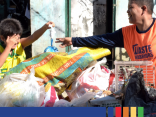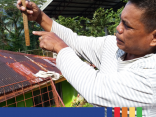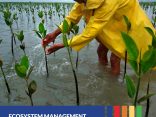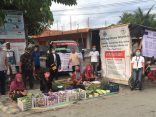From the town proper of Bokod in Benguet, Sitio Cobabeng can be reached after an hour’s drive in a 4×4 pick-up. After passing the Ambuklao Dam, the paved highway will lead to a dirt road marked by deep ruts that ordinary vehicles won’t be able to negotiate. Scars of earlier landslides are evident in many places along the road, all the way to Sitio Cobabeng.
Sitio Cobabeng is one of eight sitios that comprise Barangay Poblacion. Another sitio of Barangay Poblacion is Sitio Mangagew, which can be reached from Cobabeng after more than an hour’s drive. During rainy season, even 4×4 pick-ups would not be able to negotiate the deeply rutted dirt road to Mangagew. Being parts of the Poblacion, or the town centre, one is given the impression that the sitios are more accessible. They are not.
Moving from one sitio to another in order to cover the whole barangay is a challenge. Barangay Poblacion is one of five Bokod barangays participating in the Partners for Resilience project. The distance and travel time from Cobabeng to Mangagew illustrates the challenges the staff of CorDisRDS have to face regularly to implement disaster risk reduction that incorporates climate change adaptation and ecosystem management and restoration in five barangays in Bokod municipality. In many instances, PfR staff having no service vehicle, have to hike for hours in order to reach these communities, like during days when the roads are not passable even to 4×4 vehicles.
Sitio Cobabeng is an unofficial resettlement site. Residents moved to their present location after landslides hit their original settlement during the July 1990 earthquake. In 2009, the livelihood assets of Sitio Cobabeng residents sustained serious damage from four tropical cyclones that hit the country in one month: Ketsana, Parma, Melor and Lupit (local names Ondoy, Pepeng, Quedan and Ramil, respectively). For two weeks, they were also isolated because of numerous landslides that blocked the road to the community.
Sitio Cobabeng was one of the locations where the Philippine Tropical Cyclone Emergency Response project (PTC-1) and the Philippine Tropical Cyclones 2009 Shelter and Livelihood Recovery Project (PTC-2) were implemented with support from the European Commission Humanitarian Aid and Civil Protection department (ECHO). In PTC-1, community residents received food-for-work (FFW) assistance. With the food distribution, community members opened and cleared the road of landslide debris, restoring vital access to their community. Community members also decided to redistribute some of the food assistance they received in order to start a community-owned rice retail store.
During PTC-2, Sitio Cobabeng residents were supported in establishing their small-scale mining enterprise. The decision to support the enterprise was taken after a series of discussions on the sustainability, including environmental sustainability, of such enterprise. The enterprise was designed to apply traditional small-scale mining methods. Traditional methods do not use chemicals in processing. Less mechanization is involved. Tunnels are dug instead of the very destructive open-pit mines. The impact on the environment is there much less compared to that of non-traditional mining activities.
A start-up capital was also provided to enable to community to consolidate purchases of the gold produced so that community members will not have to deal with middlemen and intermediaries.
Three years after, during a monitoring visit for the PfR, community members proudly relate that they are able to sustain the operations of their enterprise, and that they are enjoying various benefits from it:
• After a shaky start, the community fund recovered and it has increased by 300%. From a start-up capital of PhP50,000, the community fund is now worth PhP200,000.
• Families claim that income from their participation in the enterprise enables them to send family members to school.
• Women and mothers say that emergency health needs like hospitalization for non-major cases are generally met because of income generated from participation in the enterprise.
• Resources are allocated for community activities like road repair and clearing of landslide debris. The community was able to allocate amounts spent on food during road clearing activities following recent landslides.
• The people’s organization managing the enterprise and the community fund is able to make small contributions to social activities and to families in distress, even outside the community.
• Livelihood activities have less negative impact on the environment by applying traditional practices in small-scale mining. The traditional method is less efficient but the people’s organization is looking at ways of improving efficiency without sacrificing the quality of the ecosystem.
• The community is provided alternative to participation (as labor force) in destructive, large-scale mining. The experience of Sitio Cobabeng provides other communities alternatives to participation and support to destructive, large-scale mining. Sitio Cobabeng residents are in better position to oppose destructive, large-scale mining and are making their stand on the issue.
Asked about the single most significant change that they have experienced since the CorDisRDS worked with the community in 2009, Martina Wakit, a woman leader of the people’s organization said: “In the past, our understanding of various events and phenomena (mga bagay-bagay) are fragmented and limited. We are now able to understand them better and how they are linked to one another. With better understanding, we are now more confident in the decisions and actions that we take.”





